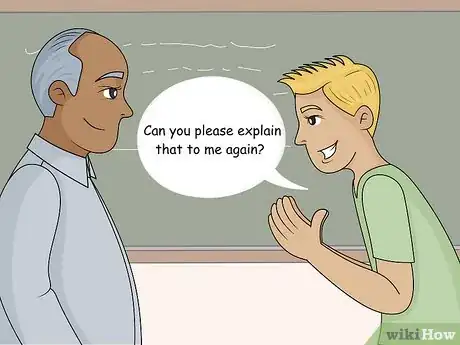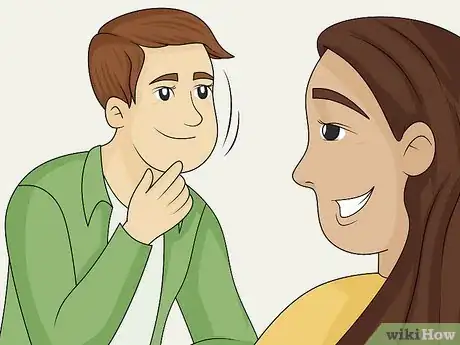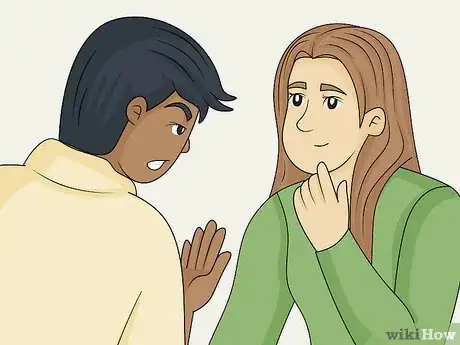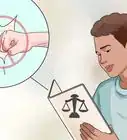This article was co-authored by Tami Claytor and by wikiHow staff writer, Hunter Rising. Tami Claytor is an Etiquette Coach, Image Consultant, and the Owner of Always Appropriate Image and Etiquette Consulting in New York, New York. With over 20 years of experience, Tami specializes in teaching etiquette classes to individuals, students, companies, and community organizations. Tami has spent decades studying cultures through her extensive travels across five continents and has created cultural diversity workshops to promote social justice and cross-cultural awareness. She holds a BA in Economics with a concentration in International Relations from Clark University. Tami studied at the Ophelia DeVore School of Charm and the Fashion Institute of Technology, where she earned her Image Consultant Certification.
There are 14 references cited in this article, which can be found at the bottom of the page.
This article has been viewed 56,522 times.
When you ask someone a question in English, it could come across as a little rude if you say something too directly. That’s why we tend to use indirect questions when we make requests. Luckily, there are a lot of different phrases that help you sound more polite. Keep reading for a ton of helpful tips and examples for how to word your questions so you're always using good manners no matter what you ask!
Steps
Phrasing a Polite Question
-
1Start with “excuse me” or “pardon me” to get a person’s attention. If you’re approaching a stranger or if you’re not already talking to the person, try out one of these phrases to start off your conversation. To sound even more courteous, try leading with “Sorry to bother you, but…” and then ask your question. Some things you could try asking include:[1]
- “Excuse me, where is the nearest bus stop?”
- “Excuse me, what time is it?”
- “Pardon me, is there a bathroom over here?”
- “Sorry to bother you, but have you seen James at all?”
-
2Begin a statement with “may” if you need to ask for permission. Starting a question with “may” is a great option for making your request sound more formal. Rather than saying directly what you need or want to do, ask the other person if it’s okay for you to do it. Some questions you could try are:[2]
- “May I use your phone for a minute?”
- “May I come in?”
- “May I make a quick suggestion?”
- “May I have some food?”
Advertisement -
3Use “can,” “could,” or “would” when you make a request. Leading right away with a question word, like “who,” “what,” “why,” “where,” or “how,” might make your question sound rude or demanding. Ease into the question with one of these words instead so it sounds a little more polite when you’re asking for information.[3]
- For example, instead of asking “Where is the bathroom?” you could say, “Would you mind telling me where the bathroom is?”
- As another example, avoid asking something like, “When does the store close?” You could ask, “Could you tell me how late you’re open?”
- Try adding the word “possibly” into your question to sound even more courteous. For example, you might ask, “Can you possibly drive me to the airport tonight?”[4]
- You could instead add the phrase to the end of your sentence if the statement initially sounds negative. For example, you could ask, “You couldn’t help me out, could you?” or “You wouldn’t mind picking me up later, would you?”[5]
-
4Say “did you want” or “did you need” to find out what someone prefers. If you’re trying to figure out what someone wants to do, try adding one of these at the start of your question. Use “did” instead of “do” when you ask your question so it sounds more indirect and polite. Some questions that use this structure include:[6]
- “Did you want some more water?”
- “Did you want to go see that movie later?”
- “Did you need some help with that?”
- “Did you have a nice weekend?”
-
5Use “know” or “remember” if you’re not sure whether the person can answer. Sometimes, you may ask a question that the other person doesn’t know the answer to. To take some of the pressure off of them to be correct, start your question with a phrase like, “do you remember,” or “would you know” so they can easily say “yes” or “no” in response. Some examples of using these phrases include:[7]
- “Do you know when the meeting starts?”
- “Would you happen to know when she’s supposed to arrive?”
- “Do you remember what he said last night?”
- “Can you remember where I left my keys?”
-
6Add the phrases “if” or “whether” when you’re posing a yes/no question. Using “if” or “whether” works best if the question doesn’t have the words “who,” “what,” “where,” “when,” or “why.” Begin your question with other phrases, like “do you” or “could you,” before adding “if” or “whether.” Some examples include:[8]
- “Do you know if the train has already left?”
- “Do you remember if we fed the dog?”
- “Could you tell me whether or not she arrived on time?”
-
7Say “please” once in your question. Saying “please” shows that you have good manners, so don’t forget to say it when you’re requesting something. You can either add please to the start or the end of your question to make it sound more courteous. Some things you might say are:[9]
- “Could you please tell me where to throw this away?”
- “Can you please explain that to me again?”
- “May I have another cookie, please?”
- “Excuse me, but would you please tell me what time it is?”
Maintaining Good Etiquette
-
1Speak in a friendly, higher tone. If you speak with a low voice or don’t change your inflection, you may come off as blunt or unfriendly. Raise the pitch of your voice slightly as you ask your question so the other person is more likely to respond to you.[10]
- Smile while you’re talking to help you naturally have a cheery tone.
-
2Let the other person speak without interruption. As the person gives you their answer, give them your full attention and avoid talking over them. Look them in the eyes and avoid getting distracted or checking your phone. Wait until the person is completely finished answering before responding to them so you get their full answer.[11]
- Avoid thinking of what to say next while the person is talking, or else you might miss important information they’re giving you.
-
3Lean in and nod to show that you’re listening. Turn your body toward the person you’re talking to and slightly lean closer to show that you’re interested in what they have to say. As they’re talking, nod or say “mmhmm” to let them know that you’re following the conversation. Keep your arms uncrossed to maintain open body language with them.[12]
- You can even repeat things the person has said back to them to prove that you’re listening.
-
4Follow-up with more questions if you need more clarification. If you’re asking about a confusing topic or if you want to continue the conversation, ask the person something else. Use their answer as a jumping-off point for your next question so you can get more information.[13]
- For example, let’s say you asked, “Could you please tell me where the nearest bus stop is?” and the person responds, “On Main Street.” You could follow up by asking, “Would you mind telling me which direction that is?”
- As another example, if you asked “Did you need some help with that?” and they say yes, you might ask, “What can I do to be the most helpful right now?”
- If you’re asking the person to repeat themselves because you missed what they said, apologize. For example, you might say, “I’m sorry, could you please repeat that for me?”[14]
-
5Steer clear of judging the other person on their answer. If you’re asking for an opinion or something about a person, keep an open mind and view it from their perspective. Even if you disagree with what the person has to say, think about it for a minute so you can understand where they’re coming from. Think about what you want to say before responding so you don’t say anything hurtful.[15]
- Try learning more about the topic on your own time so you can get a better understanding of it as well.
-
6Avoid personal or controversial questions at first. If you’re getting to know someone better, stay away from questions about things like money, politics, religion, and their personal life. A lot of people don’t feel comfortable talking about these subjects with strangers, so it could be rude to ask about them. Instead, stick to simple questions or small-talk topics, like sports, pop culture, or even the weather until you know the person better.[16]
- Reflect on if you need to know the answer or not. If it’s something that isn’t very important and could be controversial, just avoid asking it.[17]
- If you need to ask a question that may be a little awkward, start off by saying something soft and nice so the question doesn't seem as harsh or pointed.
Warnings
- Try your best to avoid direct questions, such as “Why did you do that?” or “What are you doing?” since they could come across as rude.[18]⧼thumbs_response⧽
Expert Interview

Thanks for reading our article! If you'd like to learn more about being polite, check out our in-depth interview with Tami Claytor.
References
- ↑ https://www.bbc.co.uk/learningenglish/course/lower-intermediate/unit-21/session-2
- ↑ https://www.andoverscf.org/esl-lesson-4-2
- ↑ https://speechyard.com/english-grammar/polite-question-forms/
- ↑ https://www.crownacademyenglish.com/polite-requests-english/
- ↑ https://www.crownacademyenglish.com/polite-requests-english/
- ↑ https://learningenglish.voanews.com/a/everyday-grammar-simple-past-tense/3683495.html
- ↑ https://englishwithkim.com/indirect-questions-requests/
- ↑ https://www.bbc.co.uk/learningenglish/course/lower-intermediate/unit-21/session-2
- ↑ https://www.andoverscf.org/esl-lesson-4-2
- ↑ https://files.eric.ed.gov/fulltext/EJ1247031.pdf
- ↑ https://hbr.org/2016/07/what-great-listeners-actually-do
- ↑ https://www.nytimes.com/guides/smarterliving/be-a-better-listener
- ↑ https://www.entrepreneur.com/article/254264
- ↑ https://englishwithkim.com/clarifying-confirming-understanding/
- ↑ https://www.psychologytoday.com/us/blog/living-the-questions/201410/10-reasons-stop-judging-people
- ↑ https://www.nytimes.com/guides/smarterliving/be-better-at-parties
- ↑ https://hbr.org/2020/11/the-case-for-asking-sensitive-questions
- ↑ https://speechyard.com/english-grammar/polite-question-forms/









































































